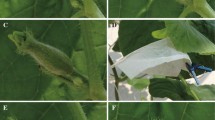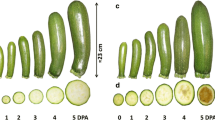Abstract
Parthenocarpy is becoming an essential trait for off-season greenhouse production of Zucchini squash. Given that winter conditions promote a reduction in the number of male flowers and in the activity of pollinators, the application of synthetic auxins is currently the most widespread method to induce fruit set. We have evaluated the parthenocarpic tendency of 48 long-fruited accessions of Cucurbita pepo spp. pepo, from morphotypes Zucchini, Vegetable marrow and Cocozelle, including 45 traditional cultivars and 3 commercial hybrids, with the goal of identifying new sources of parthenocarpy for breeding programs. After the first screening, 20 selected accessions were evaluated for the growth rate of unpollinated fruit. Twelve of the selected accessions identified as either strongly parthenocarpic or non-parthenocarpic, were compared for fruit rate growth, ethylene production and ethylene sensitivity. Apart from the three control hybrids, the fastest parthenocarpic fruit growth was observed in ‘CpCAL112’, ‘CM-37’, ‘E-27’, ‘PI261610’, and ‘V-185’. The source of the parthenocarpy of some of these accessions differs from that of the hybrids as it was not associated with the conversion of female into bisexual flowers or with the so-called “fruits with attached flowers” syndrome, which is an undesirable trait in current parthenocarpic hybrids. The alternative sources of parthenocarpy may be of great importance in current Zucchini breeding programs. We also demonstrate that the parthenocarpy of these accessions is associated with downregulation of ethylene production in unpollinated fruits during the first days post anthesis (DPA). In non-parthenocarpic accessions, unpollinated fruits boosted ethylene production at 3 DPA, concomitantly with fruit abortion and senescence, while in parthenocarpic accessions, fruits produced little ethylene at 3 DPA. Therefore, ethylene production in ovaries/fruits at 3 DPA can be used as a marker to identify and select parthenocarpy in Zucchini squash. However, in the cultivars tested here, ethylene production and sensitivity in vegetative organs and in male flowers earlier than 3 PDA do not appear well associated with parthenocarpy.







Similar content being viewed by others
References
Byers R, Baker L, Dilley D, Sell H (1972) Chemical induction of perfect flowers on a gynoecious line of muskmelon, Cucumis melo L. HortSci 9:321–331
Carbonell-Bejerano P, Urbez C, Granell A, Carbonell J, Perez-Amador MA (2011) Ethylene is involved in pistil fate by modulating the onset of ovule senescence and the GA-mediated fruit set in Arabidopsis. BMC Plant Biol 11:84
de Jong M, Mariani C, Vriezen WH (2009) The role of auxin and gibberellin in tomato fruit set. J Exp Bot 60:1523–1532
de Menezes CB, Maluf WR, De Azevedo SM, Faria MV, Nascimento IR, Nogueira DW, Gomes LAA, Bearzoti E (2005) Inheritance of parthenocarpy in summer squash (Cucurbita pepo L.). Genet Mol Res 4:39–46
de Ponti OMB, Garretsen F (1976) Inheritance of parthenocarpy in pickling cucumbers (Cucumis sativus L.) and linkage with other characters. Euphytica 25:633–642
Decker DS (1988) Origin(s), evolution, and systematics of Cucurbita pepo (Cucurbitaceae). Econ Bot 42:4–15
den Nijs APM, Balder J (1983) Growth of parthenocarpic and seed-bearing fruits of zucchini squash. Cucurbit Genet Coop Rep 6:84–85
den Nijs APM, van Zanten N (1982) Parthenocarpic fruit set in glasshouse grown zucchini squash. Cucurbit Genet Coop Rep 5:44–45
Durham G (1925) Has parthenogenesis been confused with hermaphroditism in Cucurbita? Am Nat 59:283–294
Ferriol M, Picó B, Nuez F (2003) Genetic diversity of a germplasm collection of Cucurbita pepo using SRAP and AFLP markers. Theor Appl Genet 107:271–282
Formisano G, Roig C, Esteras C, Ercolano MR, Nuez F, Monforte AJ, Picó MB (2012) Genetic diversity of Spanish Cucurbita pepo landraces: an unexploited resource for summer squash breeding. Genet Resour Crop Evol 59:1169–1184
Globerson D (1971) Effects of pollination on set and growth of summer squash (Cucumis pepo) in Israel. Expt Agr 7:183–188
Gómez P, Peñaranda A, Garrido D, Jamilena M (2004) Evaluation of flower abscission and sex expression in different cultivars of zucchini squash (Cucurbita pepo). In: Lebeda A, Paris H (eds) Progress in Cucurbit genetics and breeding research. Eucarpia-Cucurbitaceae 2004. Palacký University, Olomouc, pp 347–352
Jobst J, King K, Hemleben V (1998) Molecular evolution of the internal transcribed spacers (ITS1 and ITS2) and phylogenetic relationships among species of the family Cucurbitaceae. Mol Phylogenet Evol 9:204–219
Katzir N, Tadmor Y, Tzuri G, Leshzeshen E, Mozes-Daube N, Danin-Poleg Y, Paris HS (2000) Further ISSR and preliminary SSR analysis of relationships among accessions of Cucurbita pepo. Acta Hortic 510:433–439
Loy JB (2012) Breeding squash and pumpkins. In: Wang Y, Behera T, Kole C (eds) Genetics, genomics and breeding of cucurbits. Hew Hampshire, Science Publisher, Enfield, pp 93–139
Manzano S, Martínez C, Domínguez V, Avalos E, Garrido D, Gómez P, Jamilena M (2010) A major gene conferring reduced ethylene sensitivity and maleness in Cucurbita pepo. J Plant Growth Regul 29:73–80
Manzano S, Martínez C, Megías Z, Gómez P, Garrido D, Jamilena M (2011) The role of ethylene and brassinosteroids in the control of sex expression and flower development in Cucurbita pepo. Plant Growth Regul 65:213–221
Manzano S, Martínez C, Megías Z, Garrido D, Jamilena M (2013) Involvement of ethylene biosynthesis and signalling in the transition from male to female flowering in the monoecious Cucurbita pepo. J Plant Growth Regul 1–10
Martínez C, Manzano S, Kraaman P, Jamilena M (2008) Producción de etileno: un marcador temprano para seleccionar ginoecia en melón. Actas Hortic 51:197–198
Martínez C, Manzano S, Megías Z, Garrido D, Picó B, Jamilena M (2013) Involvement of ethylene biosynthesis and signalling in fruit set and early fruit development in zucchini squash (Cucurbita pepo L.). BMC Plant Biol 13:139
Martínez C, Manzano S, Megías Z, Barrera A, Boualem A, Garrido D, Bendahmane A, Jamilena M (2014) Molecular and functional characterization of CpACS27A gene reveals its involvement in monoecy instability and other associated traits in squash (Cucurbita pepo L.). Planta 1–15
Nee M (1990) The domestication of Cucurbita (Cucurbitaceae). Econ Bot 44:56–68
Nepi M, Pacini E (1993) Pollination, pollen viability and pistil receptivity in Cucurbita pepo. Ann Bot 72:527–536
Nitsch J, Kurtz E, Liverman J, Went F (1952) The development of sex expression in cucurbit flowers. Am J Bot 39:32–43
Om Y, Hong K (1989) Evaluation of parthenocarpic fruit set in zucchini squash. Res Rpt Rural Dev Adm (Suweon) 31:30–33
Orzáez D, Granell A (1997) DNA fragmentation is regulated by ethylene during carpel senescence in Pisum sativum. Plant J 11:137–144
Owens K, Peterson C, Tolla G (1980) Production of hermaphrodite flowers on gynoecious muskmelon by silver nitrate and aminoethoxyvinylglycine. HortSci 15:654–655
Ozga JA, Reinecke DM (2003) Hormonal interactions in fruit development. J Plant Growth Regul 22:73–81
Paris HS (1986) A proposed subspecific classification for Cucurbita pepo. Phytologia 61:133–138
Paris HS (2001) History of the cultivar-groups of Cucurbita pepo. In: Janick J (ed) Horticultural reviews, vol 25. Wiley, New York, pp 71–170
Pascual L, Blanca JM, Cãizares J, Nuez F (2009) Transcriptomic analysis of tomato carpel development reveals alterations in ethylene and gibberellin synthesis during pat3/pat4 parthenocarpic fruit set. BMC Plant Biol 9:67
Payán M, Peñaranda A, Rosales R, Garrido D, Gómez P, Jamilena M (2006) Ethylene mediates the induction of fruits with attached flower in Zucchini squash. In: Holmes GJ (ed) Proceedings of Cucurbitaceae 2006. Universal Press, Raleigh, pp 171–179
Peñaranda A, Payan MC, Garrido D, Gómez P, Jamilena M (2007) Production of fruits with attached flowers in zucchini squash is correlated with the arrest of maturation of female flowers. J Hortic Sci Biotechnol 82:579–584
Robinson RW (1993) Genetic parthenocarpy in Cucurbita pepo L. Cucurbit Genet Coop Rep 16:55–57
Robinson RW, Reiners S (1999) Parthenocarpy in summer squash. HortSci 34:715–717
Rudich J (1990) Biochemical aspects of hormonal regulation of sex expression in cucurbits. In: Bates DM, Robinson RW, Jeffrey C (eds) Biology and utilization of the Cucurbitaceae. Cornell University Press, Ithaca, pp 269–280
Rylski I (1974) Effects of season on parthenocarpic and fertilized summer squash (Cucumis pepo L.). Expt Agr 10:39–44
Rylski I, Aloni B (1990) Parthenocarpic fruit set and development in Cucurbitaceae and Solanaceae under protected cultivation in a mild winter climate. Acta Hortic 287:117–126
Saito S, Fujii N, Miyazawa Y, Yamasaki S, Matsuura S, Mizusawa H, Fujita Y, Takahashi H (2007) Correlation between development of female flower buds and expression of the CS-ACS2 gene in cucumber plants. J Exp Bot 58:2897–2907
Sanz M (1995) Fitorreguladores para el calabacín. Hortofruticultura 33:46–48
Serrani JC, Carrera E, Ruiz-Rivero O, Gallego-Giraldo L, Peres LEP, García-Martínez JL (2010) Inhibition of auxin transport from the ovary or from the apical shoot induces parthenocarpic fruit-set in tomato mediated by gibberellins. Plant Physiol 153:851–862
Srivastava A, Handa A (2005) Hormonal regulation of fruit development: a molecular perspective. J Plant Growth Regul 24:67–82
Vriezen WH, Feron R, Maretto F, Keijman J, Mariani C (2008) Changes in tomato ovary transcriptome demonstrate complex hormonal regulation of fruit set. New Phytol 177:60–76
Wien HC (2002) The cucurbits: cucumber, melon, squash and pumpkin. In: Wien HC (ed) The physiology of vegetable crops. CABI, New York, pp 345–386
Yamasaki S, Fujii N, Matsuura S, Mizusawa H, Takahashi H (2001) The M locus and ethylene-controlled sex determination in andromonoecious cucumber plants. Plant Cell Physiol 42:608–619
Author information
Authors and Affiliations
Corresponding author
Rights and permissions
About this article
Cite this article
Martínez, C., Manzano, S., Megías, Z. et al. Sources of parthenocarpy for Zucchini breeding: relationship with ethylene production and sensitivity. Euphytica 200, 349–362 (2014). https://doi.org/10.1007/s10681-014-1155-8
Received:
Accepted:
Published:
Issue Date:
DOI: https://doi.org/10.1007/s10681-014-1155-8




